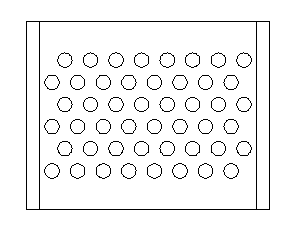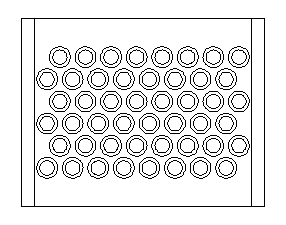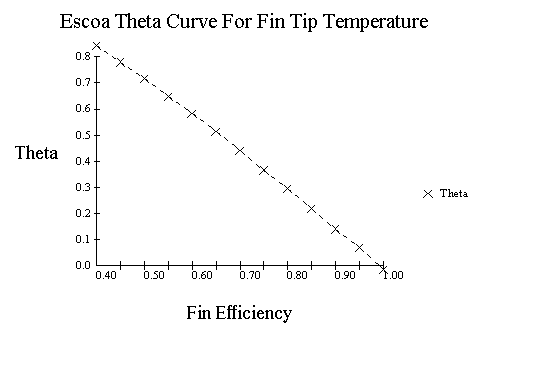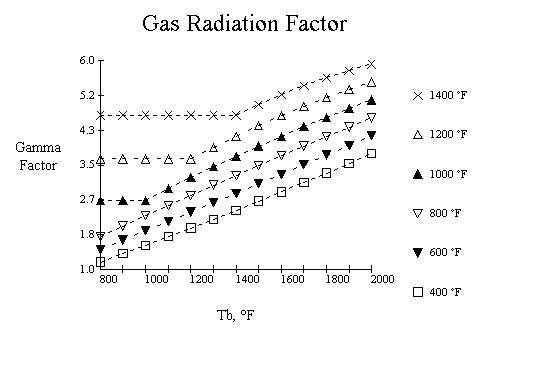Convection Section Design
This section of Fired Heater Design is divided into five main areas, which can be selected from the subject drop down box above or you may use the jump links below to go to a section. You may also use your browser "back button" to return to where you were.
| Convection Transfer, Bare Tubes | ||
| Convection Transfer, Fin Tubes | ||
| Convection Transfer, Stud Tubes | ||
| Short Beam, Reflective Radiation | ||
| Convection Section Design |
Overall Heat Transfer Coefficient, Uo:
| Uo = Overall heat transfer coefficient, Btu/hr-ft2-F |
| Rto = Total outside thermal resistance, hr-ft2-F/Btu |
| Rto = Ro + Rwo + Rio |
| Ro = Outside thermal resistance, hr-ft2-F/Btu |
| Rwo = Tube wall thermal resistance, hr-ft2-F/Btu |
| Rio = Inside thermal resistance, hr-ft2-F/Btu |
| Ro = 1/he |
| Rwo = (tw/12*kw)(Ao/Aw) |
| Rio = ((1/hi)+Rfi)(Ao/Ai) |
| he = Effective outside heat transfer coefficient, Btu/hr-ft2-F |
| hi = Inside film heat transfer coefficient, Btu/hr-ft2-F |
| tw = Tubewall thickness, in |
| kw = Tube wall thermal conductivity, Btu/hr-ft-F |
| Ao = Outside tube surface area, ft2/ft |
| Aw = Mean area of tube wall, ft2/ft |
| Ai = Inside tube surface area, ft2/ft |
| Rfi = Inside fouling resistance, hr-ft2-F/Btu |
Inside film heat transfer coefficient, hi:
The inside heat transfer coefficient calculation procedure is covered in detail, elsewhere in this course.
Effective outside heat transfer coefficient, he
| hc = Outside heat transfer coefficient, Btu/hr-ft2-F |
| hr = Outside radiation heat transfer coefficient, Btu/hr-ft2-F |
| Rfo = Outside fouling resistance, hr-ft2-F/Btu |
Outside film heat transfer coefficient, hc:
The bare tube heat transfer film coefficient, hc, can be described by the following equations.
For a staggered tube arrangement,
| hc = Convection heat transfer coefficient, Btu/hr-ft2-F |
| do = Tube outside diameter, in |
| kb = Gas thermal conductivity, Btu/hr-ft-F |
| cp = Gas heat capacity, Btu/lb-F |
| mb = Gas dynamic viscosity, lb/hr-ft |
| Gn = Mass velocity of gas, lb/hr-ft2 |
We can describe a sample bare tube bank as follows:
| Process Conditions: Gas flow, lb/hr = 100,000 Gas temperature in, °F = 1000 Gas temperature out, °F = 868 Compostion, moles N2, % = 71.5779 O2, % = 2.8800 CO2, % = 8.6404 H2O, % = 16.4044 Ar, % = 0.8609 Mechanical Conditions: Tube Diameter, in = 4.500 Tube Spacing, in = 8 Number Tubes Wide = 8 Tube Effective Length, ft = 13.000 Number Of Tubes = 48 Tube Arrangement = Staggered Pitch |
 |
For the gas properties, we can use the script we used in the radiant section design to get the properties of the gas at the average temperature.
From this program, we get the following properties,
kb, Btu/hr-ft-F = 0.0315
cp, Btu/lb-F = 0.2909
mb, cp = 0.0340 = 0.0340*2.42 = 0.0823 lb/hr-ft
To calculate the mass velocity, Gn, we need to first calculate the net free area of the tube bank. For these calculations, we are going to assume the tube rows are corbelled, so the net free area, NFA:
NFA = Nwide*tspc/12*tlgth-Nwide*tOd/12*tlgth = 8*8/12*13-8*4.5/12*13 = 30.333 ft2
Therefore,
Gn = Wgas / NFA = 100000/30.333 = 3296.739
And using our formula for hc,
The radiation transfer coefficient, hr is described later in this section. Fouling resistances, Rfi and Rfo are allowances that depend upon the process or service of the heater and the fuels that are being burned.
You will notice that the heat transfer equations for the fin tubes are basically the same as for the bare tubes untill you reach the he factor, where a new concept is introduced to account for the fin or extended surface. The procedure presented herein are taken from the Escoa manual which can be downloaded in full from the internet.
Overall Heat Transfer Coefficient, Uo:| Uo = Overall heat transfer coefficient, Btu/hr-ft2-F |
| Rto = Total outside thermal resistance, hr-ft2-F/Btu |
| Rto = Ro + Rwo + Rio |
| Ro = Outside thermal resistance, hr-ft2-F/Btu |
| Rwo = Tube wall thermal resistance, hr-ft2-F/Btu |
| Rio = Inside thermal resistance, hr-ft2-F/Btu |
| Ro = 1/he |
| Rwo = (tw/12*kw)(Ao/Aw) |
| Rio = ((1/hi)+Rfi)(Ao/Ai) |
| he = Effective outside heat transfer coefficient, Btu/hr-ft2-F |
| hi = Inside film heat transfer coefficient, Btu/hr-ft2-F |
| tw = Tubewall thickness, in |
| kw = Tube wall thermal conductivity, Btu/hr-ft-F |
| Ao = Total outside surface area, ft2/ft |
| Aw = Mean area of tube wall, ft2/ft |
| Ai = Inside tube surface area, ft2/ft |
| Rfi = Inside fouling resistance, hr-ft2-F/Btu |
Inside film heat transfer coefficient, hi:
The inside heat transfer coefficient calculation procedure is covered in detail, elsewhere in this course.
Effective outside heat transfer coefficient, he:
| ho = Average outside heat transfer coefficient, Btu/hr-ft2-F |
| E = Fin efficiency |
| Ao = Total outside surface area, ft2/ft |
| Afo = Fin outside surface area, ft2/ft |
| Apo = Outside tube surface area, ft2/ft |
And,
Average outside heat transfer coefficient, ho:
| hc = Outside heat transfer coefficient, Btu/hr-ft2-F |
| hr = Outside radiation heat transfer coefficient, Btu/hr-ft2-F |
| Rfo = Outside fouling resistance, hr-ft2-F/Btu |
Outside film heat transfer coefficient, hc:
| j = Colburn heat transfer factor |
| Gn = Mass velocity based on net free area, lb/hr-ft2 |
| cp = Heat capacity, Btu/lb-F |
| kb = Gas thermal conductivity, Btu/hr-ft-F |
| mb = Gas dynamic viscosity, lb/hr-ft |
Colburn heat transfer factor, j:
| C1 = Reynolds number correction |
| C3 = Geometry correction |
| C5 = Non-equilateral & row correction |
| df = Outside diameter of fin, in |
| do = Outside diameter of tube, in |
| Tb = Average gas temperature, F |
| Ts = Average fin temperature, F |
Reynolds number correction, C1:
| Re = Reynolds number |
Geometry correction, C3:
For segmented fin tubes arranged in,
C3 = 0.55+0.45*e(-0.35*lf/Sf)
C3 = 0.35+0.50*e(-0.35*lf/Sf)
For solid fin tubes arranged in,
C3 = 0.35+0.65*e(-0.25*lf/Sf)
C3 = 0.20+0.65*e(-0.25*lf/Sf)
| lf = Fin height, in |
| sf = Fin spacing, in |
Non-equilateral & row correction, C5:
For fin tubes arranged in,
C5 = 0.7+(0.70-0.8*e(-0.15*Nr^2))*e(-1.0*Pl/Pt)
C5 = 1.1+(0.75-1.5*e(-0.70*Nr^2))*e(-2.0*Pl/Pt)
| Nr = Number of tube rows |
| Pl = Longitudinal tube pitch, in |
| Pt = Transverse tube pitch, in |
Mass Velocity, Gn:
| Wg = Mass gas flow, lb/hr |
| An = Net free area, ft2 |
Net Free Area, An:
| Ad = Cross sectional area of box, ft2 |
| Ac = Fin tube cross sectional area/ft, ft2/ft |
| Le = Effective tube length, ft |
| Nt = Number tubes wide |
| And, |
| Ad = Nt * Le * Pt / 12 |
| Ac = (do + 2 * lf * tf * nf) / 12 |
| tf = fin thickness, in |
| nf = number of fins, fins/in |
Surface Area Calculations:
For the prime tube,
| ws = Width of fin segment, in |
We can describe a sample fin tube bank as follows:
| Process Conditions: Gas flow, lb/hr = 100,000 Gas temperature in, °F = 1000 Gas temperature out, °F = 591 Average fin temperature, °F = 755 Compostion, moles N2, % = 71.5779 O2, % = 2.8800 CO2, % = 8.6404 H2O, % = 16.4044 Ar, % = 0.8609 |
 |
|
Mechanical Conditions: Tube Diameter, in = 4.500 Tube Spacing, in = 8 Number Tubes Wide = 8 Tube Effective Length, ft = 13.000 Number Of Tubes = 48 |
Tube Arrangement = Staggered Pitch Fin Height, in = 0.75 Fin Thickness, in = 0.05 Fin Density, fins/in = 6 Fin Type = Segmented Fin Segment Width, in = 0.3125 |
For the gas properties, we can use the script we used in the radiant section design to get the properties of the gas at the average temperature.
From this program, we get the following properties,
kb, Btu/hr-ft-F = 0.0290
cp, Btu/lb-F = 0.2858
mb, cp = 0.0317 = 0.0317*2.42 = 0.0767 lb/hr-ft
To calculate the mass velocity, Gn, we need to first calculate the net free area of the tube bank. For these calculations, we are going to assume the tube rows are corbelled, so the net free area, An:
Ad = 8*13*8/12 = 69.333
Ac = (4.5+2*0.75*0.05*6)/12 = 0.4125 So,
sf = 1/6-.05=0.1167
Pl = (82-8/22)0.5=6.9282
To get a feel for the values of the coeffcient, use the following script to run various designs.
The radiation transfer coefficient, hr is described later in this section. Fouling resistances, Rfi and Rfo are allowances that depend upon the process or service of the heater and the fuels that are being burned.
Fin Efficiency, E:For segmented fins,
The average fin tip temperature is calculated as follows,
The maximum fin tip temperature is calculated as follows,
| Tsm = Maximum Fin Tip Temperature, F |
| Tgm = Maximum Gas Temperature, F |
| Twm = Maximum Tube Wall Temperature, F |
And,
The value for theta, q, can be described by the following curve.

Overall Heat Transfer Coefficient, Uo:
| Uo = Overall heat transfer coefficient, Btu/hr-ft2-F |
| Rto = Total outside thermal resistance, hr-ft2-F/Btu |
| Rto = Ro + Rwo + Rio |
| Ro = Outside thermal resistance, hr-ft2-F/Btu |
| Rwo = Tube wall thermal resistance, hr-ft2-F/Btu |
| Rio = Inside thermal resistance, hr-ft2-F/Btu |
| Ro = 1/he |
| Rwo = (tw/(12*kw))(Ao/Aw) |
| Rio = ((1/hi)+Rfi)(Ao/Ai) |
| he = Effective outside heat transfer coefficient, Btu/hr-ft2-F |
| hi = Inside film heat transfer coefficient, Btu/hr-ft2-F |
| tw = Tubewall thickness, in |
| kw = Tube wall thermal conductivity, Btu/hr-ft-F |
| Ao = Outside surface area, ft2/ft |
| Aw = Mean area of tube wall, ft2/ft |
| Ai = Inside tube surface area, ft2/ft |
| Rfi = Inside fouling resistance, hr-ft2-F/Btu |
Effective outside heat transfer coefficient, he:
For staggered and inline pitch,
| ht = Base tube outside heat transfer coefficient, Btu/hr-ft2-F |
| hso = Stud outside heat transfer coefficient, Btu/hr-ft2-F |
| Ao = Total outside surface area, ft2/ft |
| Afo = Stud outside surface area, ft2/ft |
| Apo = Tube outside surface area, ft2/ft |
| do = Outside tube diameter, in |
| Pl = Longitudinal pitch of tubes, in |
| hs = Stud outside heat transfer coefficient, Btu/hr-ft2-F |
| Gn = Mass velocity of flue gas, lb/hr-ft2 |
| Tb = Average gas temperature, F |
| Ls = Length of stud, in |
| Ds = Diameter of stud, in |
| ks = Conductivity of stud, Btu/hr-ft-F |
The gas radiation factor, hr, can be calculated from the following correlations. This factor is used in calculating the overall heat transfer coefficient for bare tubes and fin tubes. The formulas for the stud tubes has this factor built into the equations.
For bare tubes,| hr = Average outside radiation heat transfer coefficient, Btu/hr-ft2-F |
| gr = Outside radiation factor, Btu/hr-ft2-F |
| pp = Partial pressure of CO2 & H2O, , atm |
| mbl = Mean beam length, ft |
| Apo = Bare tube exposed surface area, ft2/ft |
| Ao = Total outside surface area, ft2 |
The outside radiation factor can be described by the following curves:

The following calculator will allow you to calculate the overall heat transfer coefficient for fin tubes, stud tubes, or bare tubes. This calculator uses the methods described above.
Disclaimer:
The formulas and correlations presented herein are all in the public domain and are to be used only as a learning tool. Note that any product, process, or technology in this document may be the subject of other intellectual property rights reserved by sponsors or contributors to this site. This publication is provided as is, without any warranty of any kind, either expressed or implied, including, but not limited to, the implied warranties of fitness for a particular purpose, or non-infringement.
The formulas, correlations, and methods presented herein should not be considered as being recommended by or used by the sponsors of this site. The purpose of this site is educational and the methods may or may not be suitable for actual design of equipment. Only a fired heater design engineer is qualified to decide if a calculation or procedure is correct for an application.